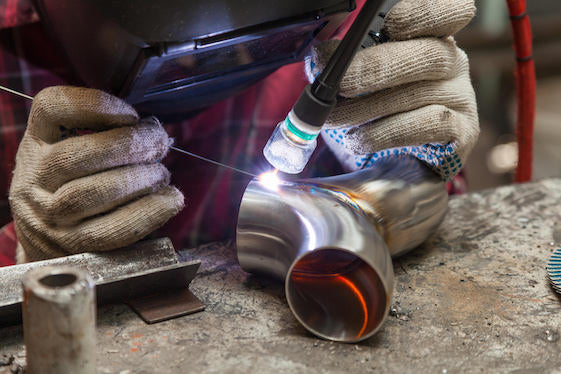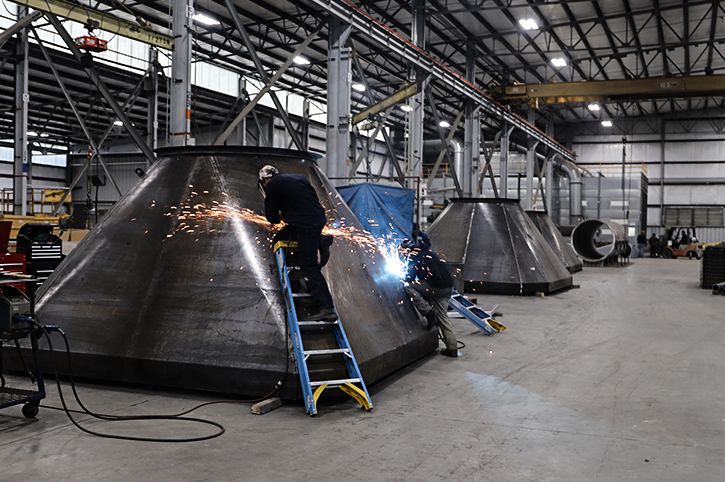Typical Welding Repair Issues and How to Address Them Properly
Welding fixings frequently encounter an array of issues that can jeopardize the stability of the last item. Typical issues consist of poor penetration, porosity, and misalignment, to name a few. Each flaw offers distinct obstacles that require specific approaches for resolution. Understanding these issues is necessary for welders intending to enhance their abilities and outcomes. This discussion will certainly explore these typical welding repair work issues and efficient methods to address them.
Insufficient Penetration
Poor penetration takes place when the weld metal stops working to completely fuse with the base product, resulting in weak joints and potential architectural failings. This problem usually originates from inadequate heat input, wrong electrode angle, or inappropriate welding rate. Welders might encounter insufficient infiltration because of a mistake of the required criteria for a particular product density or kind. Additionally, contamination on the base product's surface area can hinder reliable bonding, intensifying the issue. To resolve inadequate infiltration, welders ought to guarantee ideal settings on their tools and maintain a tidy job surface. Regular inspection of welds is suggested to determine any kind of deficiencies early, permitting for prompt corrections and the avoidance of endangered structural honesty in welded settings up.
Porosity
Porosity is a common flaw in bonded joints that shows up as little gas bubbles caught within the weld metal. This flaw can compromise the stability of the weld, causing reduced strength and possible failing under tension. Belgrade Welding. Porosity typically arises from contamination, moisture, or improper welding techniques, which enable gases to leave into the liquified weld swimming pool. To resolve porosity, welders must guarantee appropriate surface area prep work, maintain a tidy functioning environment, and make use of ideal welding parameters. In addition, choosing the best filler product and protecting gas can mitigate gas entrapment. Normal evaluation and testing of welds can aid determine porosity early, guaranteeing timely rehabilitative actions are taken, consequently preserving the top quality and integrity of the bonded structure
Imbalance
Misalignment in welding can occur from numerous factors, including inappropriate setup and thermal expansion. Recognizing the source is essential for reliable resolution. Several modification methods are readily available to realign components and assure structural honesty.
Root causes of Imbalance
Welding misalignment often stems from a variety of underlying concerns that can compromise architectural honesty. One main cause is improper fit-up of elements prior to welding, which can cause gaps and unequal surface areas. Variants in thermal growth during the welding process can also lead to distortion, especially if the products being signed up with have various coefficients of development. Additionally, poor securing and fixturing may stop working to hold parts safely in location, leading to movement throughout welding. Poorly kept devices, including welding equipments and devices, may introduce incongruities in the weld bead, further adding to misalignment. Finally, driver mistake, coming from inadequate training or experience, can likewise play a substantial duty in creating misaligned welds.
Adjustment Techniques Available
Attending to misalignment effectively needs a combination of restorative techniques customized to the certain issues at hand. One common technique is making use of fixtures or jigs to hold elements in the appropriate position during welding, making sure constant positioning. In addition, pre-heating the products can help reduce distortion and enhance fit-up. For significant imbalance, mechanical realignment strategies, such as making use of hydraulic jacks or clamps, can be utilized to deal with the position prior to welding. Post-weld warm therapy may also be needed to relieve stresses brought on by imbalance. Finally, cautious examination and modification during the setup phase can prevent misalignment problems from coming to be significant issues, promoting a smoother welding procedure and enhancing total architectural stability.
Distortion
Distortion is a typical obstacle in welding that can occur from different elements, including irregular home heating and air conditioning. Recognizing the reasons for distortion is necessary for executing effective prevention methods. Resolving this concern not just boosts architectural honesty yet also improves the overall top quality of the weld.
Reasons of Distortion
When based on the extreme warm of welding, products usually go through adjustments that can cause distortion. This sensation mostly emerges from thermal development and tightening throughout the welding procedure. As the weld area heats up, the product expands; upon cooling, it acquires, which can create inner anxieties. Furthermore, unequal home heating across a workpiece can exacerbate these tensions, causing warping or flexing. The kind of product likewise plays a considerable duty; metals with differing thermal conductivity and coefficients of expansion might react differently, leading to uncertain distortions. Furthermore, inadequate joint design and inadequate fixturing can contribute to imbalance throughout welding, boosting the likelihood of distortion. Recognizing these reasons is essential for effective welding repair and prevention strategies.
Prevention Techniques
Effective avoidance techniques for distortion during welding focus on controlling heat input and making sure appropriate joint layout. Preserving a constant warm input helps to minimize thermal development and tightening, which can cause distortion. Making use of strategies such as preheating the workpiece can likewise reduce the temperature slope, advertising consistent heating. Furthermore, picking proper joint styles, such as T-joints or lap joints, can boost stability and lower stress and anxiety focus. Implementing appropriate fixturing to secure the workpieces in hot air welder area further help in maintaining positioning during the welding procedure. Staggered welding series can distribute warmth more evenly, protecting against local distortion. By using these methods, welders can considerably reduce the likelihood of distortion and boost the overall top quality of their welds.
Breaking
Fracturing is an usual problem experienced in welding repairs, usually resulting from numerous factors such as incorrect cooling rates, product selection, or inadequate joint prep work. The incident of cracks can greatly jeopardize the integrity of the weld, causing potential failures during operation. To address this problem, welders should initially examine the source, guaranteeing that products are compatible and properly chosen for the specific application. In addition, regulating the air conditioning price during the welding procedure is crucial; quick cooling can generate stress and anxiety and result in cracking. Appropriate joint style and preparation also add to lessening the threat. Carrying out these strategies can enhance weld quality and toughness, eventually reducing the probability of breaking in ended up weldments.

Incomplete Fusion
A significant issue in welding fixings is insufficient combination, which happens when the weld steel does not appropriately bond with the base product or previous weld passes - Fabrication. This problem can cause weaknesses in the joint, potentially jeopardizing the honesty of the welded structure. Aspects contributing to incomplete blend consist of inadequate heat input, inappropriate welding technique, and contamination of the surface areas being joined. To resolve this concern properly, welders need to guarantee appropriate pre-weld cleaning and surface area prep work, along with adjust their welding specifications to achieve ample penetration and blend. Normal examination throughout the welding procedure can additionally assist identify insufficient fusion early, allowing for timely rehabilitative steps to enhance the overall quality of the weld
Overheating
While welding repair work can boost architectural stability, overheating provides a significant obstacle that can bring about product destruction. Excessive heat throughout welding can change the mechanical homes of steels, causing minimized toughness, increased brittleness, and bending. This sensation is especially critical in high-stress applications where structural dependability is extremely important. Recognizing getting too hot can include aesthetic evaluations for staining or distortion, in addition to monitoring temperature level throughout the welding procedure. To minimize the threats connected with overheating, welders must utilize appropriate methods, such as controlling heat input, readjusting travel speed, and making millerwelds use of appropriate filler products. In addition, carrying out pre- and post-weld heat treatments can help restore product residential or commercial properties and improve the general high quality of the fixing, guaranteeing long-lasting performance and security.
Regularly Asked Inquiries
What Are the Common Signs of a Welding Defect?

How Can I Check My Welds for Quality?
To check welds for top quality, one can make use of aesthetic evaluations, ultrasonic testing, and radiographic approaches. Each method ensures architectural honesty, recognizes flaws, and validates adherence to defined requirements, inevitably improving the dependability of the bonded joints.
What Safety Safety Measures Should I Take While Welding?
When welding, one ought to prioritize security by putting on appropriate personal safety equipment, making sure proper air flow, safeguarding combustible products away, maintaining a tidy office, and knowing surroundings to avoid mishaps and injuries.
Can I Fix a Weld Without Redesigning the Entire Joint?
Repairing a weld without redesigning the whole joint is possible, depending on the damage (Montana Mobile Welding and Repair Belgrade Fabrication). Techniques such as grinding, adding filler material, or making use of a welding process can successfully attend to details flaws while maintaining the surrounding structure
What Tools Are Essential for Reliable Welding Repairs?
Necessary devices for effective welding repair work consist of a welding equipment, cord brush, mill, protective gear, clamps, and filler products. Each device plays a crucial function in ensuring quality and safety during the repair work procedure. my sources Porosity commonly emerges from contamination, wetness, or inappropriate welding strategies, which allow gases to run away into the liquified weld swimming pool. Badly kept equipment, including welding machines and tools, might introduce incongruities in the weld grain, further adding to misalignment. When subjected to the extreme heat of welding, materials often go through modifications that can lead to distortion. Splitting is a common concern run into in welding repair work, usually resulting from numerous variables such as incorrect air conditioning rates, material selection, or poor joint prep work. A significant problem in welding repair services is insufficient blend, which happens when the weld steel does not properly bond with the base material or previous weld passes.